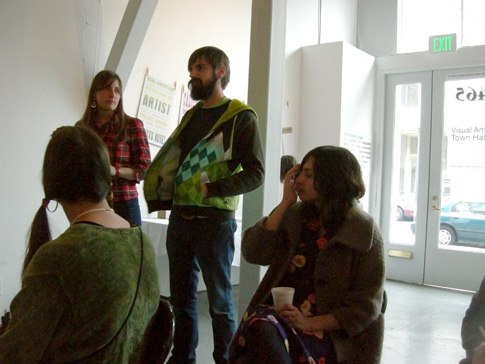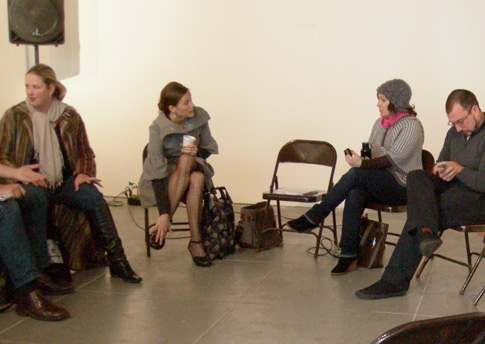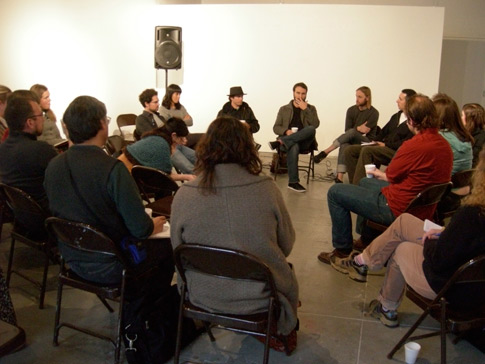Town Hall Meeting Recap
February 23rd, 2009 by eleanor - art and politics arts funding bay area blog events news State of the Arts TPG artists TPG8
 Oliver and I thank everyone for coming, introduce ourselves, the State of the Arts project, and Joseph
Oliver and I thank everyone for coming, introduce ourselves, the State of the Arts project, and Joseph
 The first panel settles in (L-R: David Huff’s legs (Pro Arts), Christian Frock (Invisible Venue), Svea Lin Vezzone (Swarm Gallery), Kerri Johnson (Blank Space), Mike Bianco (Queens Nails Projects)
The first panel settles in (L-R: David Huff’s legs (Pro Arts), Christian Frock (Invisible Venue), Svea Lin Vezzone (Swarm Gallery), Kerri Johnson (Blank Space), Mike Bianco (Queens Nails Projects)
 The Artist Respondents move front and center
The Artist Respondents move front and center
The goal of the day was to get a bunch of people talking about issues like arts funding, government and the arts, the stimulus, the economy and what that means for artists, and interesting ways that all these areas may interact. This we accomplished. It is incredibly hard to get a bunch of artists and arts activists who already have an incredibly full work load together and come up with some immediate solutions to any problems, so we didn’t leave the meeting with a clear course of action, but I think that is ok. We’re still really early on, and just hearing out different ideas and perspectives is always fruitful.
I came away with a couple of things in particular though:
1. If artists want more money from government, they have to show up to meetings and prove themselves as a constituency and fight for what they want. They could team up with real estate brokers who know how artists turn areas from bad neighborhoods to desirable ones. They can fight for money in all aspects of government. Someone suggested that every single government project could have some sort of artistic element to it. Even if the budgets for this type of work are small, if these jobs are given only to Oakland (or whichever city you live in) artists, the impact could add up. Mike Bianco spoke about the possibility of starting a union. If a union charged some dues, maybe each locality could hire a lobbyist.
2. The stimulus for the NEA, in comparison to a lot of things, is still very small. Lori Zook, from the Oakland Cultural Arts and Marketing Division, suggested that we look not just to the NEA to get our hands on some stimulus money, but also through Education programs and Community Development Programs. She said there are billions of dollars being funneled into those programs. Now, this assumes that you’d have to fit your art into one of those categories, which is not always the easiest things to do. I was talking to my sister about grants and writing for them in general. Grant writers are incredibly adept at not necessarily fibbing about their projects, but just using the language and framework that the granters want to see. Perhaps we need to become creative in thinking of the ways that our work could be framed.
I was just talking to Joseph and he thinks this idea is a little bogus, as art should be funded because it is art and we and others should see the value in doing just that. I believe that, but it seems clear in this country that many policy makers do not believe that. So I’m ending at one of the very first topics/quandries of the discussion: how to make people understand, believe in, and fund art for its simple value as cultural capital.
6 Comments »
Additional comments powered by BackType










It’s going to be finish of mine day, except before end I
am reading this enormous piece of writing to improve
my experience.
I really hope you have another Town Hall Meeting. I think I have a lot to add to this conversation and it is an interesting one, indeed.
I can also recommend a book called *The $12 Million Stuffed Shark: The Curious Economics of Contemporary Art* by Don Thompson. I am reading this book now and there is a chapter on Art and Money which is interesting and relevant and talks about The Netherlands’ support of artists and why it didn’t work and was ultimately discontinued. Also, there was an artists’ group in England that tried to get artists assigned to paid positions at different government agencies. I do not remember the name of this group from the ’60s or ’70s.
I think we need to fashion a cohesive statement (a case statement) regarding the direct funding of artists to start with and to answer any potential objections that might be around. BTW, government agencies do not directly fund artists, less because of a fear of controversial art (most artists don’t do controversial work), but because artists are perceived as being unreliable. They will take the money and then produce (or not produce) anything of real value. It is safer to give the money to arts organizations that can be held accountable and are in a better position to judge the “worthiness” of artists and their work. There is a history of the NEA which talks about this. I used to be on The LAB Board and believe me, we really wanted to give the artists more money which rarely happened. Also you are in competition with the performing arts which gets the lions share of funding vis a vis the visual arts. They have made a better case for funding themselves. I also think locally the performing arts are over-represented on the SFAC grants review board. I could so go on.
Hi Allegra,
Thanks for your comments and book recommendation. I am intrigued by this idea of getting artists into paid governmental positions. Someone suggested at this meeting (I think it was Amy Balkin) governmentally sponsored artists to serve as goodwill ambassadors, traveling to and making work in different countries. They could help promote understanding and communication between the cultures.
The problem with holding artists “accountable” is that “real value” contributions to culture and society are hard to measure. If we hope to find more individual governmental funding for artists in the future, this idea of measuring value has to change. The idea needs to be that art is valuable in and of itself within the culture and the communities. The funding of individual artists would be an acknowledgment of that.
It is true that if anything substantial is to come of these meetings, there has to be an effort to hone the message. Our goal was to start the conversation and help make some connections between different parties. To that effect, I think we succeeded. However for real change to happen, some leadership has to be taken and supporters will need to be moved to action.
Hi Eleanor,
I just lost everything I was typing. Well, again, the group from England I was talking about was The Artists Placement Group which involved artists in the daily operations and planning of selected governmental departments like Environment and Health etc. Cultural exchanges between countries is usually handled through the State Department or used to be.
As to the value of art, I had recommended to Joseph that he read The Gifts of the Muse, a study done by the Rand Corporation, about the visual arts. Everyone should read this study. It is the beginning of a case statement.
By accountability, I mean the problem of giving money to artists who then do not produce anything or who do not finish the project. Granting agencies have had that experience and so are shy of giving direct grants to artists. Mediating organizations such as alternative arts groups write periodic reports to granting agencies telling what progress is being made and how successful the project has been or not. Arts groups know that if nothing comes of the money spent, they will not receive future funding for other artists.
Worthwhile: Hmmm. Of course, you know that some art work is better than others. Innovative work is the most highly prized, and not all art work is innovative, or even interesting. But who determines worthwhileness? Several individuals and groups are gatekeepers in different realms, including art markets (there are more than one) and art institutions, collectors and curators, and other arts organizations.
As I suggested, we really need a case statement as to why the visual arts and artists should be supported and need support. As I said, the performing arts have done a great job of that, relatively. I would definitely be interested in continuing the work you all have started, so please keep in touch.
This is a comment on my comment. I should also mention (and maybe it is more relevant) about funding through art organizations. The tax codes require that granting agencies give to 501(c)(3)s for tax benefits. Even though artists can get fiscal sponsors, not all agencies allow for this.
congrats!! looks like a success!!!